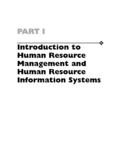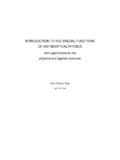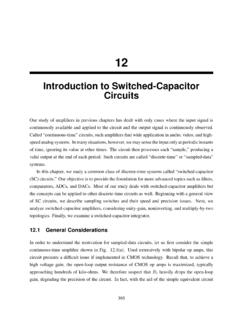Transcription of SYSTEM SOFTWARE - JIMS Lajpat Nagar Delhi
1 SYSTEM SOFTWARE . BCA - 502. SYSTEM SOFTWARE . BCA - 502. This SIM has been prepared exclusively under the guidance of Punjab Technical University (PTU) and reviewed by experts and approved by the concerned statutory Board of Studies (BOS). It conforms to the syllabi and contents as approved by the BOS of PTU. Reviewer Senior Professor, School of Computing Sciences, Dr. N. Ch. Iyengar VIT University, Vellore Author: Sanjay Saxena Copyright Author, 2006. Reprint 2008, 2009, 2010. All rights reserved. No part of this publication which is material protected by this copyright notice may be reproduced or transmitted or utilized or stored in any form or by any means now known or hereinafter invented, electronic, digital or mechanical, including photocopying, scanning, recording or by any information storage or retrieval SYSTEM , without prior written permission from the Publisher. Information contained in this book has been published by VIKAS Publishing House Pvt.
2 Ltd. and has been obtained by its Authors from sources believed to be reliable and are correct to the best of their knowledge. However, the Publisher and its Authors shall in no event be liable for any errors, omissions or damages arising out of use of this information and specifically disclaim any implied warranties or merchantability or fitness for any particular use. Vikas is the registered trademark of Vikas Publishing House Pvt. Ltd. VIKAS PUBLISHING HOUSE PVT LTD. E-28, Sector-8, Noida - 201301 (UP). Phone: 0120-4078900 Fax: 0120-4078999. Regd. Office: 576, Masjid Road, Jangpura, New Delhi 110 014. Website: Email: CAREER OPPORTUNITIES. Computer SOFTWARE engineers are projected to be one of the fastest growing occupations in the next decade. Computer applications SOFTWARE engineers analyse users' needs and design, construct, and maintain general computer applications SOFTWARE or specialized utility programs. Computer SYSTEM SOFTWARE engineers coordinate the construction and maintenance of a company's computer systems and plan their future growth.
3 SYSTEM SOFTWARE engineers work for companies that configure, implement, and install complete computer systems. Increasing emphasis on computer security suggests that SOFTWARE engineers with advanced degrees that include SYSTEM design will be sought after by SOFTWARE developers, government agencies, and consulting firms specializing in information assurance and security. As is the case with most occupations, advancement opportunities for computer SOFTWARE engineers increase with experience. Entry-level computer SOFTWARE engineers are likely to test and verify ongoing designs. As they become more experienced, they may become a project manager, manager of information systems, or chief information officer. Some computer SOFTWARE engineers with several years of experience or expertise find lucrative opportunities working as SYSTEM designers or independent consultants or starting their own computer consulting firms. The largest concentration of computer SOFTWARE engineers - almost 30 per cent - are in computer SYSTEM design and related services.
4 Rapid employment growth in the computer SYSTEM design and related services industry, which employs the greatest number of computer SOFTWARE engineers, should result in very good opportunities for those college graduates with at least a bachelor's degree in computer engineering or computer science and practical experience working with computers. Employers will continue to seek computer professionals with strong programming, SYSTEM analysis, interpersonal and business skills. New growth areas will continue to arise from rapidly evolving technologies. The increasing uses of the Internet, the proliferation of Web sites, and mobile technology such as the Wireless Internet have created a demand for a wide variety of new products. As individuals and businesses rely more on hand-held computers and wireless networks, it will be necessary to integrate current computer systems with this new, more mobile technology. Also, information security concerns have given rise to new SOFTWARE needs.
5 Concerns over "cyber security" should result in businesses and government continuing to invest heavily in SOFTWARE that protects their networks and vital electronic infrastructure from attack. The expansion of this technology in the next 10 years will lead to an increased need for computer engineers to design and develop the SOFTWARE and systems to run these new applications and integrate them into older systems. PTU DEP SYLLABI-BOOK MAPPING TABLE. BCA - 502 SYSTEM SOFTWARE Section-I. introduction to SOFTWARE Processors: Elements of assembly language Unit 1: introduction to SOFTWARE programming; assembly scheme, single pass and two-pass assembler; general Processors (Pages 3-19). design procedure of a two-pass assembler. Section-II. Macros and Macro Processor: Macro definition, macro expansion, and features Unit 2: Macros and Macroprocessor of macro facility, design of macro processor. (Pages 20-37);. Overview of Compilers: Memory allocation, lexical analysis, syntax analysis, Unit 3: introduction to Compilers Intermediate code generation and optimization-local and global optimization, (Pages 38-49).
6 Code generation. Section-III. Loaders and Linkage Editors: introduction to loading, linking and relocation, Unit 4: Loaders and Linkage Editor program linking, linkage editors, dynamic linking, bootstrap loader. Other (Pages 50-68);. SYSTEM SOFTWARE : Operating SYSTEM , DBMS, Functions and structure of Text Unit 5: Other SYSTEM Softwares Editor. (Pages 69-79). CONTENTS. introduction 1. UNIT 1 introduction TO SOFTWARE PROCESSORS 3 19. introduction ; Unit Objectives;. introduction to SOFTWARE Processors;. Complex Instruction Set Computer (CISC); Reduced Instruction Set Computer (RISC);. Hybrid Processors; Special Purpose Processors Elements of Assembly Language Programming;. Instructions; Integer expressions; Reserved Words and Identifiers; Directives Assembly Scheme;. Single-Pass and Two-Pass Assembler;. Working of an Assembler; Single-Pass Assembler; Two-Pass Assembler General Design Procedure of a Two-Pass Assembler; Summary;. Answers to Check your Progress'; Exercises and Questions; Further Reading UNIT 2 MACROS AND MACROPROCESSOR 20 37.
7 introduction ; Unit Objectives; Macro Definition;. Macro Expansion; Nested Macro Calls;. Features of Macro Facility;. Macro Instruction Arguments; Conditional Macro Expansion; Macro Instructions Defining Macros Design of a Macro Pre-processor;. Implementation of Two-Pass Algorithm; Implementation of Single-Pass Algorithm Summary; Answers to Check your Progress';. Exercises and Questions; Further Reading UNIT 3 introduction TO COMPILERS 38 49. introduction ; Unit Objectives;. Overview of Compilers;. Cross Compiler; One-Pass or Multi-pass Compiler; Source-to-source Compiler;. Stage Compiler; Just-in-time Compiler Structure of Compiler;. Scanner; Parser; Symbol Tables and Error Handler;. Contextual Checkers; Intermediate Code Generator;. Code Optimizer; Code Generator; Peep Hole Optimizer Example of a Compiler;. Phases of a Compiler;. Lexical Analysis Phase; Syntax Analysis Phase;. Intermediate Code Generation Phase; Native Code Generation Phase; Optimization Phase Summary; Answers to Check your Progress'.
8 Exercises and Questions; Further Reading UNIT 4 LOADERS AND LINKAGE EDITORS 50 68. introduction ; Unit Objectives;. Overview of Loaders and Linkers;. Object Modules; Binary Programs Loaders;. Compile and Go Loader; Absolute Loader;. Relocating Loaders; Direct-Linking Loaders Linkage Editor;. Program Relocation; Program Linking Design of a Linker;. First Pass; Second Pass Dynamic Linking; Bootstrap Loader; Summary;. Answers to Check your Progress'; Exercises and Questions; Further Reading UNIT 5 OTHER SYSTEM SOFTWARES 69-79. introduction ; Unit Objectives; Operating SYSTEM ;. Types of Operating Systems;. Multiprocessing Operating SYSTEM ; Multitasking; Multi-user;. Multithreading; Real-time Operating SYSTEM Functions of Operating SYSTEM ;. Process Management; Memory and Storage Management; Protection and Security DataBase Management SYSTEM (DBMS);. Data; Hardware; SOFTWARE ; End Users Entities and Relationships; Functions and Structure of Text Editor; Summary.
9 Answers to Check your Progress'; Exercises and Questions; Further Reading introduction introduction . SYSTEM SOFTWARE is necessarily an important concept in order to communicate with your computer SYSTEM . It is required to understand the architecture and the interface NOTES. used in a SYSTEM so that it becomes easy for a programmer to administer the instructions provided. In this book, we will discuss the concepts that include the use and implementation of assemblers, macros, loaders, compilers and operating systems. We have made an attempt to present all these components in detail with the help of examples. How This Book is Organized This book is divided into five units: Unit 1 introduction to SOFTWARE Processors discusses the SOFTWARE processors. You will get to know about the different elements of an assembly language programming. It, thereafter, describes the general design procedure of a two-pass assembler. The next section in this chapter discusses about the SOFTWARE tools in which the concept and design of text editor is mentioned.
10 Unit 2 Macros and Microprocessors explains the concept of defining and expanding macros. Followed by this, it describes various features of macro facility. It also focuses your attention on different types of interpreters and loaders. Unit 3 Compilers helps understand the aspects of compilation and different phases of a compiler. In addition, you will learn about the important concepts related to linkers such as relocating and linking. Unit 4 Loaders and linkers discusses about the loaders and linkers that helps in the creation of a program. Linkers connect the object module with the binary program. The loaders help converting the source program into the object program. Unit 5 Other SYSTEM SOFTWARE discusses about the operating SYSTEM . It also describes the various types of operating systems such as multiprocessing and multitasking. The functions of operating SYSTEM are also discussed in detail. In addition, this unit also gives an overview of database management SYSTEM .







